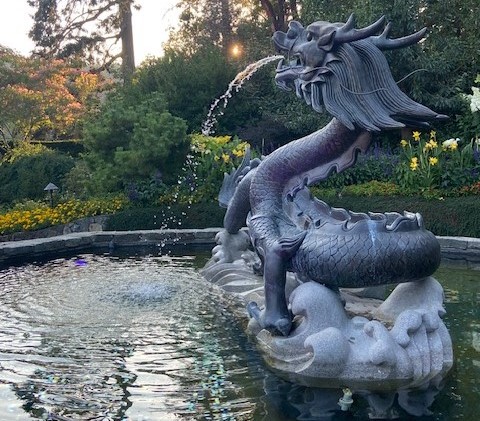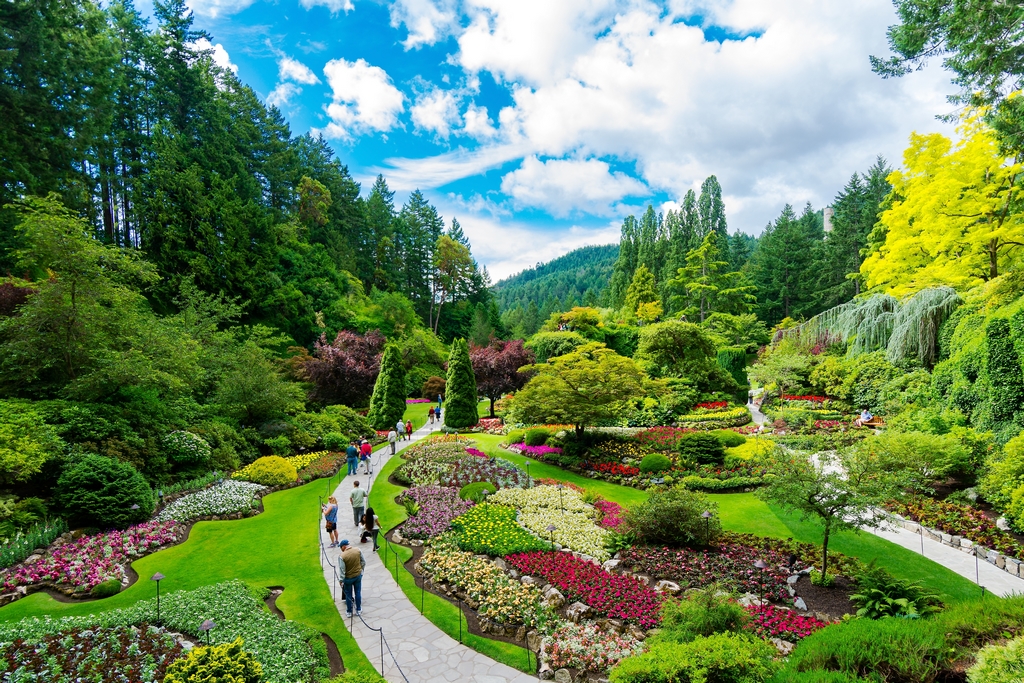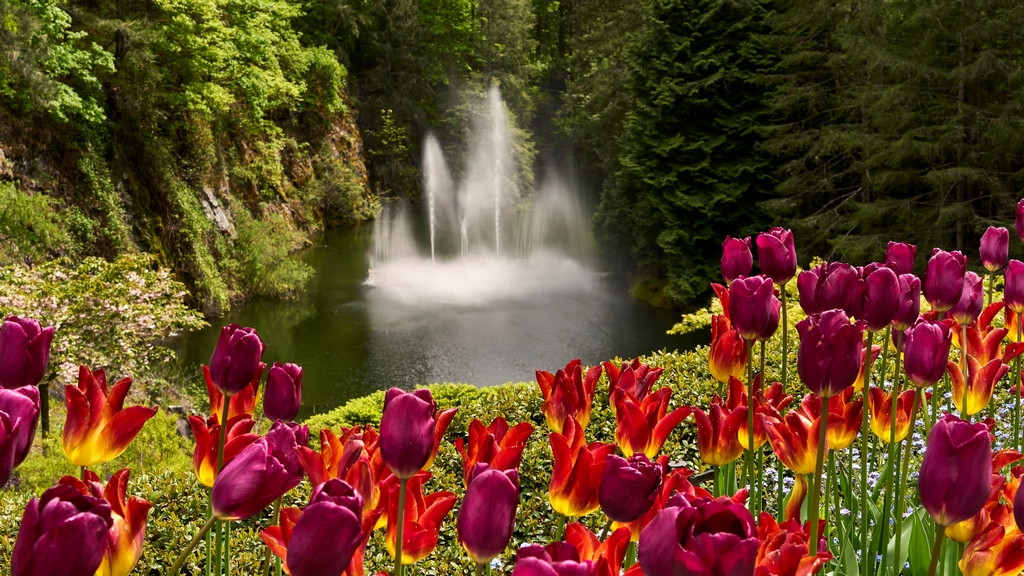Butchart Gardens: A Living Legacy of Beauty and Innovation


Nestled on Vancouver Island in British Columbia, Canada, Butchart Gardens is a world-renowned botanical garden that attracts over a million visitors annually. Its stunning landscapes, vibrant flowers, and meticulously designed water features have made it a must-see destination for garden enthusiasts and tourists alike.
Eric Herman
Back on August 8th this summer, my wife Diane and I celebrated her birthday with a visit to the storied Butchart Gardens. We had heard about the place for years, having lived in nearby Washington State, but had never been there.
Our beautiful late-afternoon and early-evening visit was embroidered by the sights, sounds and fragrances abundant on the sprawling property, that was once, ironically a place ravaged by a quarry, but now elevated by the loving embrace of some of North America’s most beautiful garden spaces.
Beyond its aesthetic appeal, Butchart Gardens has a rich history and cultural significance that continues to captivate people worldwide. It began as a vision of Jennie Butchart, the wife of Robert Pim Butchart, a pioneer in the cement industry. In 1904, Robert Butchart established a limestone quarry on the property in what is now the Tod Inlet area. As the quarry was exhausted, Jennie saw an opportunity to transform the barren landscape into a lush garden.
Equipped with a passion for gardening and an eye for beauty, Mrs. Butchart began importing topsoil by horse and cart, and in 1906, the first seeds of what would become the ‘Sunken Garden’ were sown.
Jennie Butchart’s vision expanded over the years, incorporating different styles and themes into the garden that gradually developed into distinct spaces. By the 1920s, Butchart Gardens had become a popular attraction, with visitors flocking to see the blossoming landscapes. The gardens have remained in the Butchart family ever since, with each generation contributing to its growth and preservation.
EVOLVING DESIGNS
Butchart Gardens is a masterpiece of landscape architecture, blending natural beauty with artistic design. The gardens cover 55 acres and feature a variety of themed areas, each with its own distinct character.
- The Sunken Garden is perhaps the most iconic part of Butchart Gardens. It occupies the site of the original limestone quarry and is a testament to Jennie Butchart’s vision of transforming industrial wasteland into a paradise. The garden features a large central lawn, surrounded by pathways, flowerbeds, and rock formations. The careful arrangement of plants and flowers creates a tapestry of colors and textures that change with the seasons.
- The Rose Garden was added in 1929 and showcases a wide variety of roses, including hybrid teas, floribundas, and climbers. The garden is laid out in a formal style, with neatly trimmed hedges and pathways leading visitors through arches of blooming roses.
- The Japanese Garden was commissioned in 1912 and designed by the renowned landscape architect Isaburo Kishida. This serene garden features winding paths, stone lanterns, and carefully pruned trees, creating a peaceful retreat that contrasts with the more formal European-style gardens.
- The Italian Garden was created in the space that once housed the Butcharts’ tennis court. It features a reflecting pool, classical statues, and symmetrical flowerbeds, embodying the elegance of Renaissance-style gardens.
WATERSHAPES APLENTY
Water plays a central role in the design of Butchart Gardens, enhancing the beauty and tranquility of the space, while providing unique destinations throughout. The gardens feature several fountains and water features, each carefully integrated into the landscape, each a celebration of art and nature.
- The Ross Fountain, installed in 1964, is a highlight of the Sunken Garden. It was commissioned by Ian Ross, Jennie Butchart’s grandson, and was named in honor of his family. The fountain features multiple jets of water that create a dynamic and ever-changing display; illuminated at night to create a magical atmosphere.
- The Star Pond, located in the Italian Garden, was originally designed as a swimming pool for the Butchart children. It was later transformed into a decorative pond, with a star-shaped design and a central fountain.
- The Fountain of the Three Sturgeons was purchased and installed in 1973. The striking bronze casting was taken from the enlargement of a work created by famed sculptor Sirio Tofanari in 1958.
- The Dragon Fountain (pictured above), a striking bronze dragon sculpture was a gift from Victoria’s sister city Suzhou, China. The magnificent two-meter-high by three-meter-long bronze and granite sculpture was given in conjunction with the 35th anniversary of the Sister-City relationship with the City of Victoria as a celebration of nature and international unity.
- The Japanese Garden ponds form a sprawling waterway that gentle cascades through the gardend, connected by small streams and waterfalls. These water features are integral to the garden’s design, reflecting the traditional Japanese aesthetic of harmony with nature.
THE PLANT KINGDOM
Butchart Gardens is home to an astounding variety of flowers and plant species, with over 900 varieties of bedding plants used each year. The gardens are carefully curated to ensure that something is always in bloom, regardless of the season.
Spring brings a riot of color to Butchart Gardens, with tulips, daffodils, and hyacinths carpeting the gardens. Cherry blossoms and magnolias add to the spectacle, creating a breathtaking display of nature’s renewal.
In summer, the gardens are at their most vibrant, with roses, begonias, and dahlias taking center stage. The Sunken Garden is particularly stunning at this time of year, with every corner bursting with life.
Autumn at Butchart Gardens is a time of rich, warm colors. Japanese maples, chrysanthemums, and asters add to the seasonal palette, while the Japanese Garden is particularly striking as the leaves turn shades of red and gold.
Even in winter, Butchart Gardens remains a place of beauty. The gardens are adorned with lights and decorations for the Christmas season, and the mild coastal climate allows for a surprising variety of winter blooms.
LOVE’S LABOUR
Butchart Gardens is not just a place of beauty; it is also a cultural and historic landmark. The gardens have been designated a National Historic Site of Canada, recognizing their importance as a testament to early 20th-century landscape design and their role in Canada’s horticultural heritage.
The gardens have hosted countless events and celebrations over the years, including concerts, fireworks displays, and horticultural exhibitions. They have also inspired generations of gardeners and landscape architects, serving as a living example of what can be achieved with vision, dedication, and a love of nature.
As Butchart Gardens continues to thrive, the challenge of preserving its beauty for future generations remains a priority. The Butchart family, along with a dedicated team of gardeners and staff, work tirelessly to maintain the gardens’ pristine condition. This vast effort involves not only caring for the plants and flowers but also preserving the historical integrity of the site. It is a meticulous labor of love.
Sustainability is also a key focus, with efforts to reduce the gardens’ environmental footprint through water conservation, composting, and the use of organic fertilizers. Educational programs and workshops are offered to visitors, promoting the importance of environmental stewardship and inspiring a new generation of gardeners.
As we recently discovered, Butchart Gardens is more than just a beautiful destination; it is a living legacy of innovation, creativity, and respect for nature. From its humble beginnings as a limestone quarry to its status as one of the world’s most famous gardens, it continues to enchant visitors with its breathtaking landscapes, diverse plantings, and rich history.
As it looks to the future, Butchart Gardens remains a shining example of how human ingenuity and a deep connection to the natural world can transform a ravaged landscape to create something truly extraordinary.
Photos: Dragon Fountain by Eric Herman; Sunken Garden by Marianne Sullins | Shutterstock, Ross Fountain by Louise Kellow | Shutterstock, Japanese Garden by Meandering Trails Media | Shutterstock, The Fountain of the Three Sturgeons by Matthew Roberge.
References: “Jennie’s Masterpiece . . . The Story of Butchart gardens”, www.notesonboardingpass.com, and, Heroes, Heroines and History: Butchart Gardens, www.hhhistory.com.













